Today’s pictures were from the Grand People’s Study House, a giant library overlooking the Taedong River, with the Juche Tower on the other side.
Sorry for how long some captions are. I formatted them to be more readable but WordPress seems to ignore the formatting. I hope you can read them okay anyway.
- Nearly all big public buildings we visited had big statues of Kim Il Sung, Kim Jung Il, or both. The statues nearly always represent them as paternal, optimistic, smiling, or displaying some emotion conducive to leadership. Some looked magnificent. After a few you got bored with them but wondered what the deal was with so many of them. Who decided to put so many up? How many would they consider too many? Then again, walking around other cities you see a lot of crosses, crescents, six-pointed stars, and such.
A friend commented on the above picture and caption when I posted it on a social networking site, to which I responded
- I wanted to make the statue look even more domineering by taking the angle from below. Needless to say, all his statues have him towering above — though his preserved body in the mausoleum is lying down and you look down to see it. After I took the picture a few people in my group reminded me we weren’t supposed to take pictures from this angle. The guides were still outside at that point so I didn’t get official word from them. I didn’t remember that rule. I heard that at the airport on the way some officials examined the cameras of people in other groups and deleted some photographs. What types of photographs would you expect them to delete? I heard they were pictures of representations of Kim Il Sung that didn’t capture the whole thing, like the head was cut off.
- Kim Il Sung appears calm and wise here. The history and stories about him and his son differ widely between what the North Korean government says and what sources outside the country say. I heard that North Korea permits almost no practice of Christianity because many stories of Kim Il Sung are copied from stories about Jesus. The stories about Jesus are probably copied from older religions themselves.
- The North Korean government enjoys a fair degree of popular support from its people. People keep asking me why and how that can be given their understanding of the country’s problems. It takes a while to get, but when you see it from the people’s perspective it makes sense. The most fundamental point you have to understand to understand them is to know what information they have and they don’t. They close their border to nearly all information flow. The North Korean government tells its people that the rest of the world is materially worse off than they are, that the U.S., after having started and lost the Korean War, is trying to starve them, and that their leaders are doing everything they can to help them, among much else information.
- The government does not allow anyone to tell them other places are materially better off, that the U.S. provides huge amounts of aid and food, North Korea invaded South Korea, and that few outside North Korea consider the North Korean leadership helpful to its own people. When you let go of your beliefs and the information on which you base them, and adopt the beliefs the North Korean government instills in its people, you see supporting its government makes sense.
- Personally, I don’t find the government’s story credible, but I have information the North Korean people don’t.
- Blurry picture. The caption for the next picture, of the same room, is better.
- A large lecture hall in the main library building in Pyongyang. It must be difficult to concentrate with the leaders bearing down on you like that. But maybe it warms their hearts. I have no idea. The thing is, every time I feel like I can’t get over how bizarre their system of the cult of personality the North Korean government imposes on its people, I think of how here we would have a giant logo, maybe not in the library, but maybe.
- Certainly a lecture hall like this, if holding a lecture on, say, medicine, would be filled with pharmaceutical logos. In a sporting environment — forget about it, logos everywhere. I’m not writing about advertising to compare it with North Korean propaganda. It’s just that seeing that new-to-me part of their culture forced me to see something in our environment. I don’t care about the comparison. I care about raising my awareness of what in my environment we’ve created as a culture and how it affects my thoughts, behavior, and such.
- How many things do I not notice because I’m like a fish in water? How does my life change by raising my awareness of those things. Our ads, like their propaganda, are designed to influence you. They keep paying to put them up, suggesting they work. How much do you like people you don’t know influencing you to buy their stuff? Beyond influencing individual purchases here and there, what system of interactions and values does our culture support?
The same friend who responded above responded to this picture and caption, to which I responded
- This painting was in a hallway outside the previous room. I remember seeing paintings with this theme a few times — rebels fighting, a strong woman taking charge, intense action, yet oddly static, not showing the dynamic action of American comic books, for example.
- A detail of the previous painting. I’m not sure whom they are fighting here — the Japanese, Americans, South Koreans, or others. I’m not sure if that’s Kim Il Sung, another important figure, or a regular fighter behind the woman holding him back and firing. (EDIT — see comment from reader below, who knew the painting subjects)
- A classroom for foreign language study. They were studying English when we visited. The screens above got saturated in this picture so you can’t see the English phrases on them. The students didn’t pay much attention to us, so I think they were used to foreigners observing their classrooms. I think all the classes in this building were for adult education.
- Another room had a bunch of portable stereos. Someone had put one on playing American country music. Seeing so many signs of interest in the West and the U.S. suggested to me that, despite the government’s condemnation of the U.S., the people viewed at least the people and culture of the U.S. with more curiosity and interest. I think most people recognize people are people when governments aren’t decrying them as enemies.
- The view out the balcony shows a huge square, I think called Kim Il Sung Square. I’m pretty sure pictures I’ve seen of military parades go across that avenue and square. We visited the Juche Tower across the river later on our tour.
- A close-up of the proud image, as far as my camera would zoom in from the same spot as the previous picture. I don’t know what the text says (EDIT: see comment from reader below). If anyone can tell me what it says, please do.
- We walked by the spot pictured here later, after visiting the foreign language book store where an odd incident happened. Someone in our group bought some ice cream cones and soda (weird tasting, I forget how someone described it). I ended up with an ice cream cone and didn’t want to finish it. Nobody else wanted it either because it tasted so weird. I walked over to a trash can by the bus stop about ten car-lengths behind the white van in this picture. When I walked back to the group, one of our tour guides was flipping out at me, asking me what I did and why. I told him I just threw the trash away in that trash can. He asked me if I had interacted with a little girl. When I looked back I saw a little girl at the bus stop I hadn’t noticed before, not far from the trash can.
- I don’t know what the problem would have been for me to have spoken or interacted with a regular person, as opposed to the government-trained guides, but he seemed very concerned. Of all the differences between North Korean and most other places’ policies, the openness about being allowed to talk to anyone and go wherever you want ranks near the top.
- A grand view. Very autocratic. A nearly empty plaza of nearly unusable space — except for the military parades, I guess. We also entered the subway from the staircase on the left of the square across the avenue, near the river.
- Zooming in on the Juche Tower, apparently the tallest stucture of its kind in the world. I think they built it about a meter taller than the Washington Monument. I also understand that they keep the lights on it at night even when the rest of the city loses power. Anyway, later pictures will show the tower up close, viewing the river from the other side, where a large group of female soldiers were practicing in formation.
- People ask me why I went to North Korea. The answer is this man, Jordan Harbinger, and this birthday message from him “Hey happy birthday man! All the best! What do you have planned for this year? p.s. I’m going to North Korea in August -get jealous! ;)” I had no plans even to consider visiting North Korea. Had I thought to go on my own I wouldn’t have followed through.
- Had I gone on my own, I can’t imagine having half as great a time as I could have with the group that seemed to self-assemble around him. I mean, Neil Strauss is a celebrity in any crowd, but I felt Jordan set the tone for this trip. I didn’t learn until partway through the trip that Jordan and Joseph Ferris III had been planning this trip for years, which I learned hearing how much he knew about North Korea before we came when he’d tell alternate versions of North Korean history than the ones the guides were telling us. Also from the seriousness of the plans for future trips.
- What was the tone? You have to know Jordan. He has a law degree, but he’s more of a successful adventurer in life. He founded a school to teach men and women social and dating skills called The Art of Charm as well as creating and producing a series of recordings of others who teach social and dating skills called Pickup Podcast. He’s recorded nearly all the best in the world in that world. He has a radio show on Sirius he is about to take to a new level. He has a serious following. So all that says he’s a successful entrepreneur who is so social and fun to be around others pay to learn from him, who attracts others like that. He’s what magazines like GQ, Esquire, and Maxim suggest a man should be like. Most men would benefit from being more like him. The point of describing him is not to flatter him, but to illustrate the character that if someone like him suggests going to North Korea in a group of his friends, only an idiot would decline.
- That I couldn’t afford it would just be a hurdle that overcoming would just add to the trip’s reward. I didn’t know until later what ended up being the best parts of the trip were in store — the ultimate tournament, the Mass Games (I had never heard of them), the other people. If you know Jordan you know those things will come together. Throw in that I had just visited, loved, and made great friends in Shanghai a month before, an excuse to revisit there only added. That it had blown my budget didn’t factor in. I could save money for a year to make up for the extra trip. As with many of the best parts of my life, the reasons I loved them were different than the reasons I chose to go (business school and vipassana meditation come to mind).
- This trip was valuable for the experiences most of which, as I mentioned, I couldn’t have anticipated. They expanded my awareness of how people could live and therefore how I could. But the reason I chose to go was mainly faith in this guy. … also that it’s f’ing North Korea.
Jordan responded to this post on another site:
Hey man this is truly awesome, thanks so much. Glad you could make the trip with us. 🙂
I responded
When I first posted it, the sentence “Most men would benefit from being more like him.” said “Most men would benefit from having a bit more of Jordan in him” until I realized some might misread it.
A different, mutual friend:
Did they show you the slave labor camps?!?
Joseph:
as much as they wanted to show us their slave labor camps the camps are located in a very remote area and they still dont have the tourist facilities up and running to have this as part of the tourist intinerary yet
Me:
No labor camps this visit.
- My roommate, Alex, and me with the Juche Tower between us
- Dorky me. Note: I’m wearing my old “Be Yourself Danny Tenaglia” t-shirt. Also, more cool autocratic, patriotic art in the background.

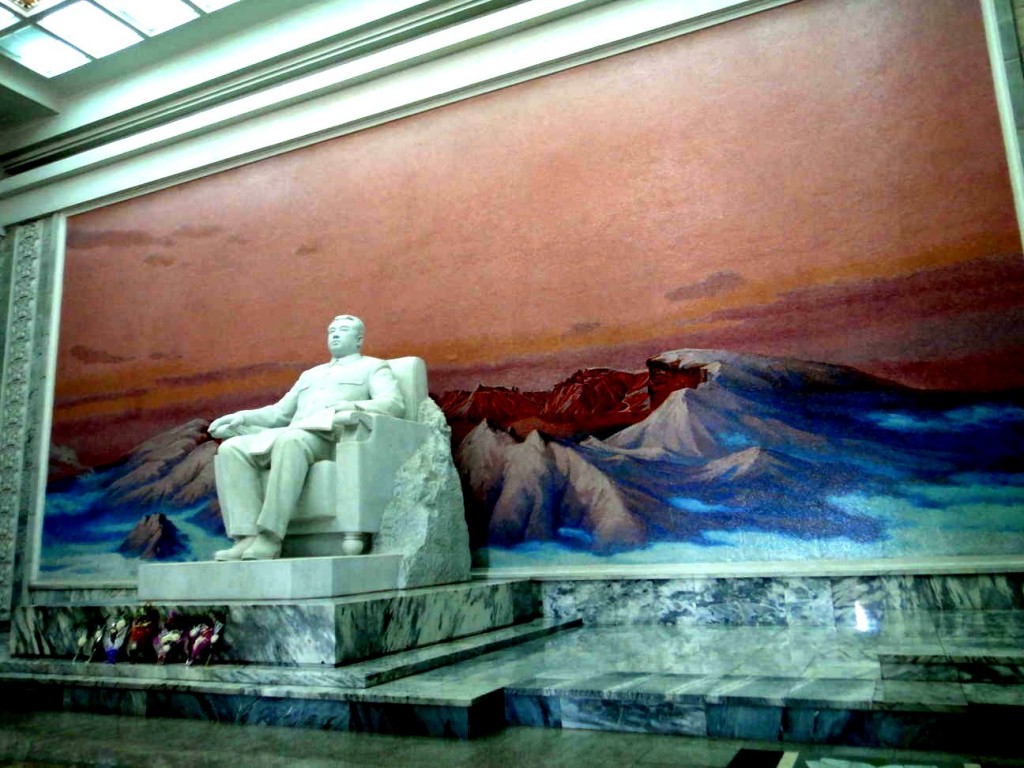


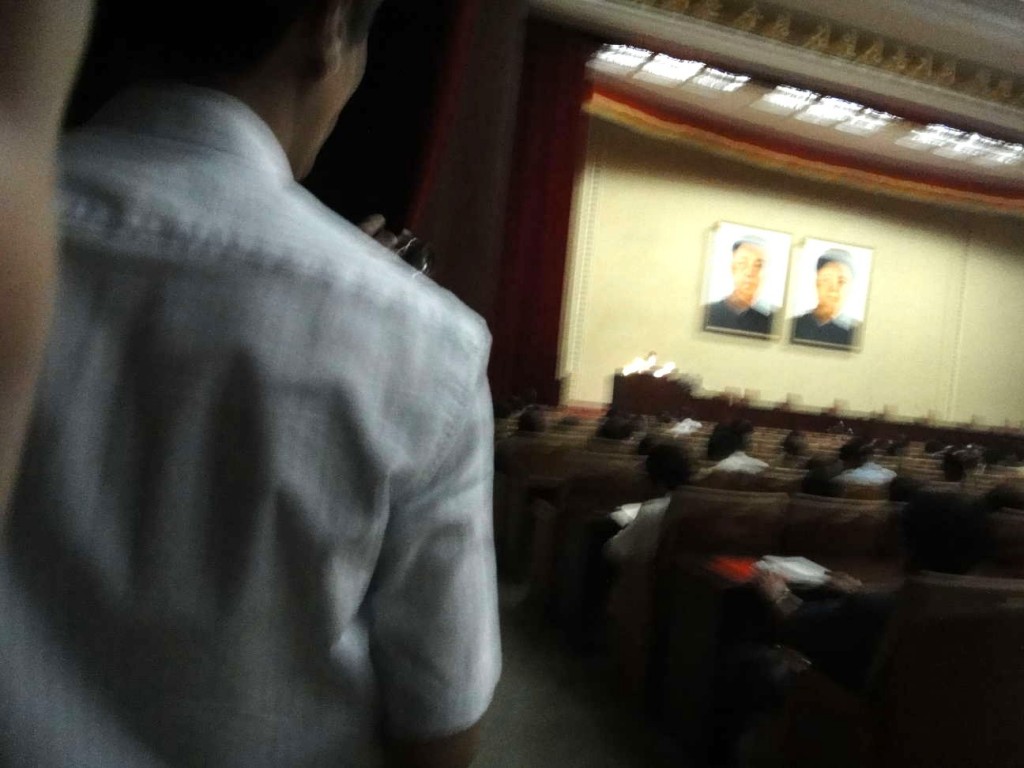
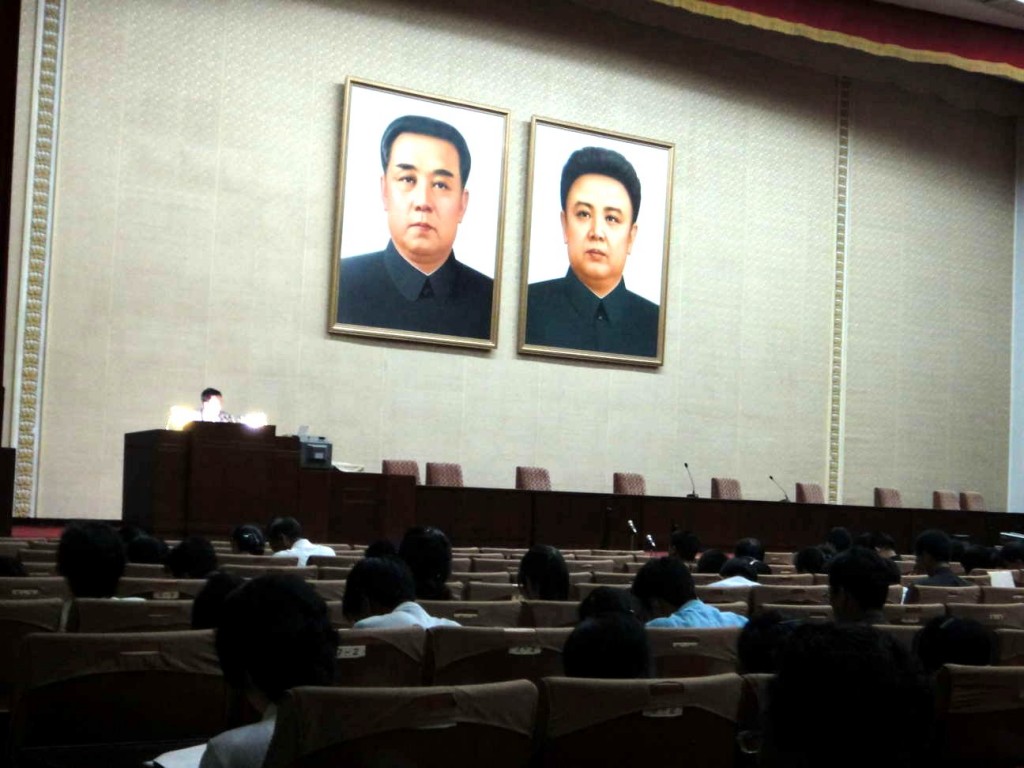






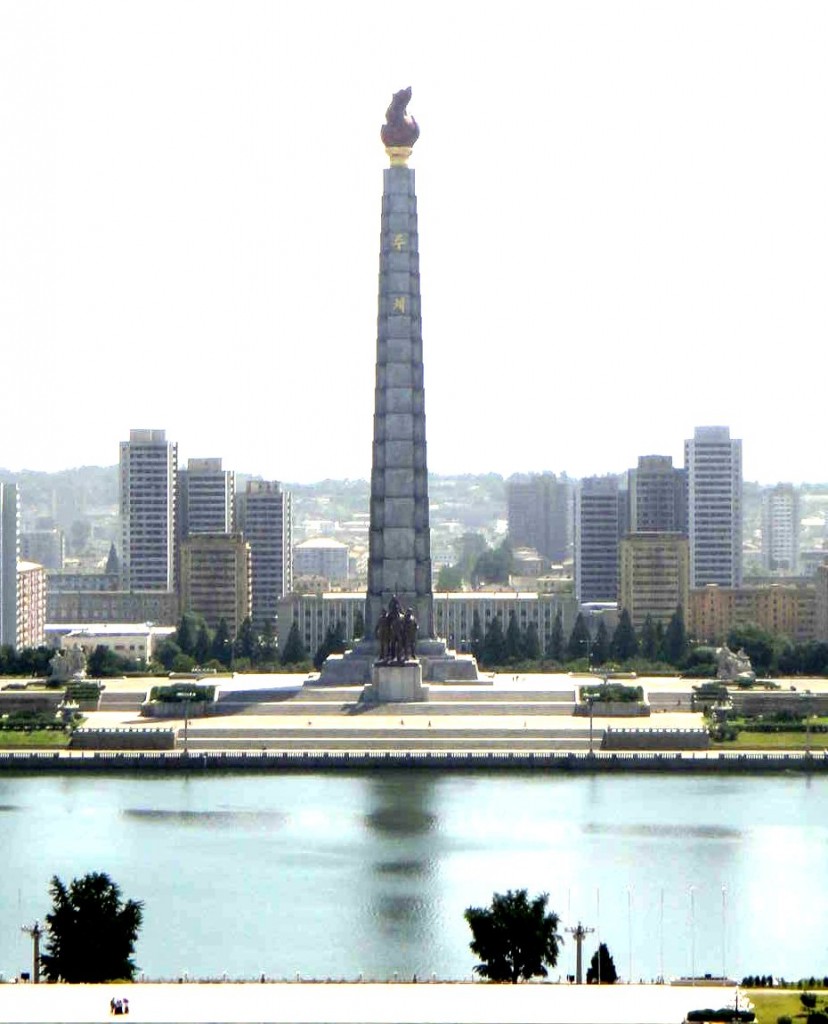
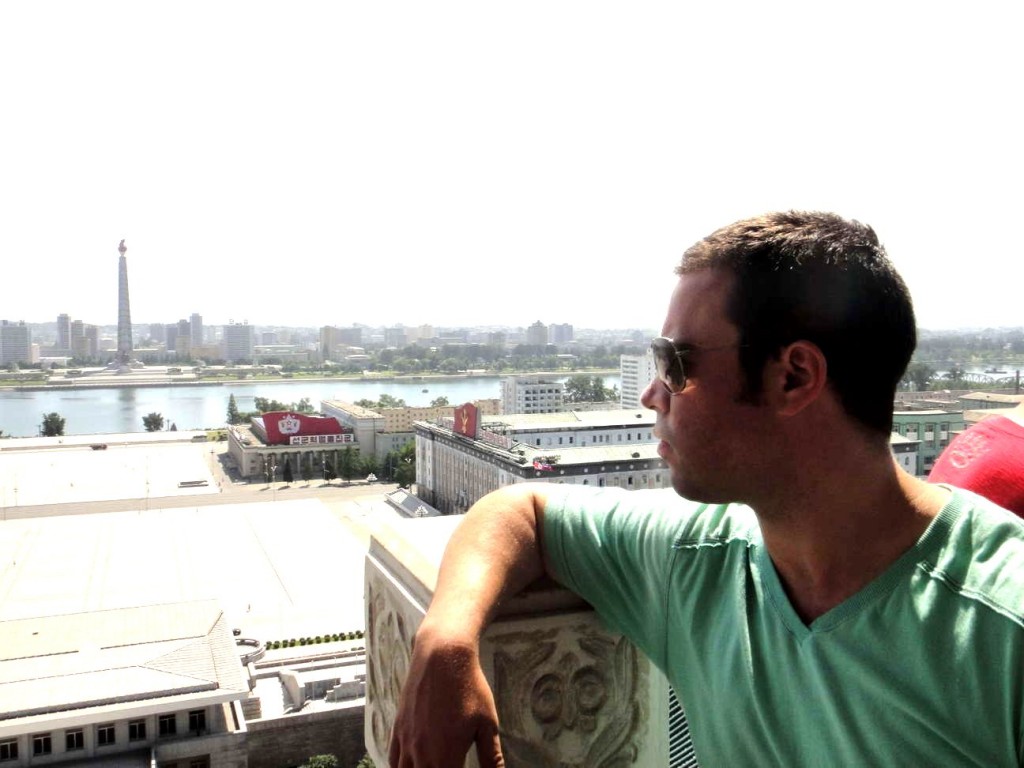


The text reads “Revolutionary Spirit of Mt. Baekdu”. The left part of the image is Mt. Baekdu with the Heavenly Lake.
The painting depicts the Anti-Japanese guerilla activity of Kim Il Sung. The woman in front of Kim Il Sung is his wife (and mother of Kim Jong Il) Kim Jong Suk.
Simon, thanks for the background on the painting and sign!
I should have known the heroic image must have been Kim Il Sung.